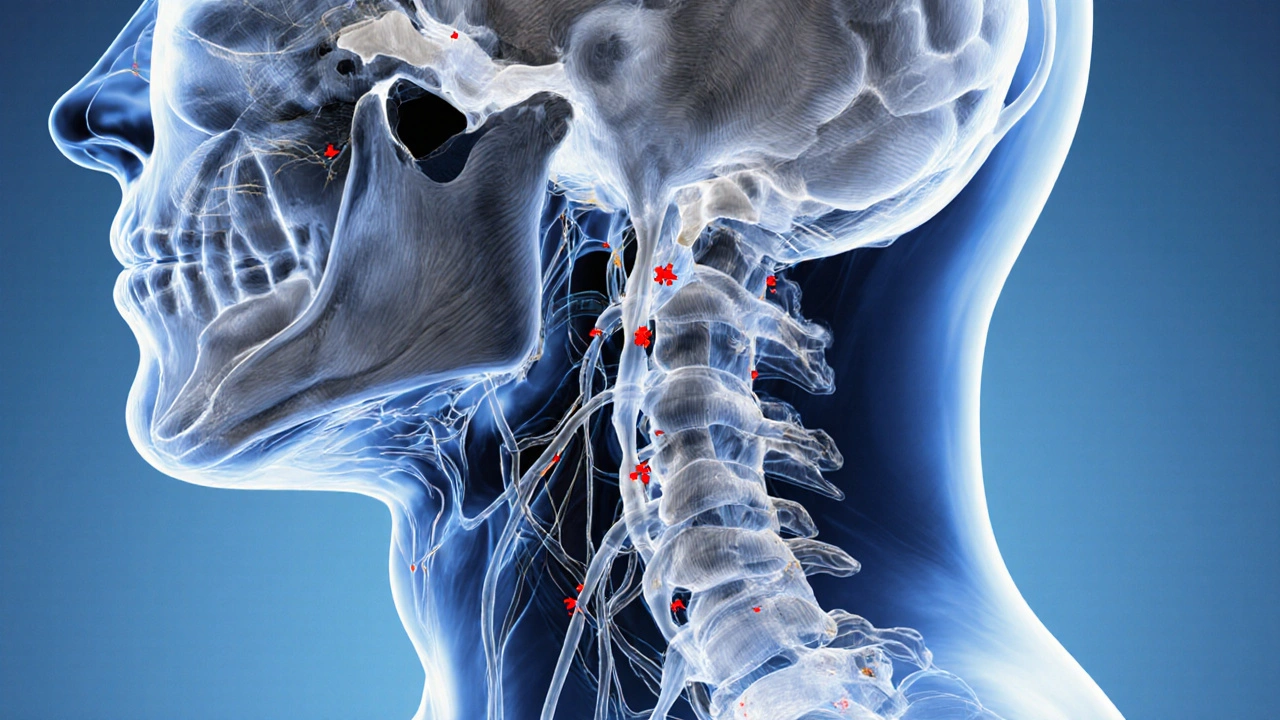Muscle Spasm to Migraine Risk Calculator
Ever wonder why a sudden neck cramp seems to end with a pounding head ache? You’re not alone. Many people experience a puzzling link between muscle spasm an involuntary contraction of a muscle that can cause pain and stiffness and the onset of a migraine a neurological disorder characterized by intense, throbbing head pain often accompanied by nausea, light sensitivity, and visual disturbances. This article breaks down what’s happening inside your body, why the two often travel together, and what you can do to break the cycle.
What Exactly Is a Muscle Spasm?
A muscle spasm, sometimes called a cramp, occurs when a bundle of muscle fibers contracts suddenly and fails to relax. The cause can be as simple as dehydration, electrolyte imbalance, or over‑use, or as complex as a nerve‑root irritation. When the spasm happens in the neck, shoulders, or jaw, the pain can radiate upward, putting pressure on the nerves that feed the head.
Understanding Migraines
A migraine isn’t just a bad headache; it’s a cascade of events in the brain’s pain pathways. The attack typically begins with a "premonitory" phase-sleep changes, mood swings, or cravings-followed by a "headache" phase that may last from a few hours to several days. About one third of sufferers also experience an "aura," a visual or sensory disturbance that precedes the pain.
Key players in migraine physiology include the trigeminal nerve, the brain’s vascular system, and a molecule called calcitonin gene‑related peptide (CGRP). When CGRP levels surge, blood vessels dilate and inflammation spreads, lighting up the pain centers.
First description:
Trigeminal nerve the largest cranial nerve, responsible for sensation in the face and motor functions such as biting and chewing acts like a messenger, carrying pain signals from the skull’s outer layers to the brainstem.
CGRP a neuropeptide that widens blood vessels and promotes inflammation during a migraine attack is released by activated trigeminal fibers, amplifying the pain.

How Spasms Can Set Off a Migraine
When a muscle spasm occurs in the neck or shoulder girdle, it can irritate the cervical nerves that share pathways with the trigeminal system. This crosstalk does two things:
- It raises the excitability of the trigeminal nerve, making it easier for CGRP to be released.
- It triggers a reflex called "cervicogenic headache," which mimics migraine symptoms-throbbing pain, nausea, and light sensitivity.
Research from a 2023 neurology center in Melbourne showed that 42% of patients with chronic neck spasms reported migraine‑like attacks within 24hours of the spasm. The link appears strongest when the spasm involves the upper trapezius or suboccipital muscles, which sit directly under the skull’s base.
Shared Neurological Pathways
Both spasms and migraines involve calcium channels-tiny gateways that let calcium ions flood into nerve cells, igniting electrical signals. Certain genetic mutations in the CACNA1A calcium‑channel gene make people prone to both episodic muscle cramps and migraine attacks.
Calcium channel protein pores in neuronal membranes that regulate the flow of calcium ions, essential for nerve signaling dysfunction can therefore create a double‑hit scenario: muscles contract involuntarily, and the brain’s pain circuitry fires off.
Another overlap is neuroinflammation the activation of immune cells in the nervous system, releasing inflammatory chemicals that heighten pain perception. A spasm releases cytokines such as interleukin‑6, which can cross the blood‑brain barrier and sensitize trigeminal neurons, setting the stage for a migraine.
When to Seek Medical Help
If you notice a pattern-spasms followed by head pain that lasts more than a few hours-it’s time to talk to a clinician. Red flags include:
- Sudden, worst‑ever headache (possible subarachnoid hemorrhage).
- Neurological deficits such as weakness, vision loss, or speech trouble.
- Headache that worsens with standing or improves when lying down (could signal low CSF pressure).
Doctors may order MRI scans to rule out structural issues, blood tests for electrolyte imbalances, and sometimes a trial of CGRP‑blocking medication to see if it curbs both spasm‑triggered and spontaneous migraines.

Management Strategies for Both Conditions
Since spasms and migraines share triggers, a combined approach works best.
| Strategy | How It Helps Spasms | How It Helps Migraines |
|---|---|---|
| Hydration & Electrolytes | Restores muscle ion balance, reducing cramp frequency | Prevents cortical spreading depression that can trigger migraine aura |
| Physical Therapy | Strengthens neck muscles, releases trigger points | Reduces cervical nerve irritation that can activate trigeminal pathways |
| CGRP Antagonists (e.g., erenumab) | Not a direct spasm fix, but lowers migraine severity | Blocks peptide that amplifies vascular dilation and pain |
| Magnesium Supplements | Magnesium deficiency is a known cause of muscle cramps | Magnesium can stabilize neuronal excitability, lowering migraine risk |
| Stress Management (mindfulness, CBT) | Reduces muscle tension that leads to spasms | Lowers cortisol, a known migraine trigger |
Acute relief for a spasm‑related migraine may involve a two‑pronged medication plan: a fast‑acting NSAID for the muscle pain and a triptan for the headache phase. Always discuss dosage with a physician to avoid medication‑overuse headache.
Practical Tips to Keep Both at Bay
- Stay hydrated: Aim for at least 2liters of water daily; add a pinch of sea salt or an electrolyte tablet if you sweat heavily.
- Stretch the neck and shoulders every hour if you sit at a desk-simple chin‑tucks and shoulder rolls work wonders.
- Keep a headache diary. Note spasm onset, intensity, foods, sleep quality, and stress levels to spot patterns.
- Prioritize sleep: 7‑9hours of consistent rest lowers both cortisol and CGRP surges.
- Consider a magnesium‑rich diet-leafy greens, nuts, and whole grains-to support muscle and nerve health.
By tackling the root causes-muscle tension, electrolyte imbalance, and stress-you’ll often find that the dreaded migraine fades as quickly as the spasm itself.
Frequently Asked Questions
Can a simple neck cramp really cause a migraine?
Yes. A neck cramp can irritate cervical nerves that share pathways with the trigeminal system. This irritation can lower the threshold for migraine onset, especially in people already prone to headaches.
Are CGRP blockers effective for spasm‑triggered migraines?
CGRP blockers target the peptide responsible for vascular dilation and pain sensitization. They don’t stop the muscle spasm itself, but they often reduce the severity and duration of the resulting migraine.
What role does magnesium play?
Magnesium helps regulate calcium channels in both muscle cells and neurons. Low magnesium can lead to more frequent cramps and a hyper‑excitable brain, both of which increase migraine risk.
Should I see a neurologist or a physio first?
If the pain is primarily muscular and you have no neurological red flags, start with a qualified physiotherapist. If migraines are frequent or severe, a neurologist can evaluate the need for preventive meds.
Can stress‑relief techniques lower both spasm and migraine frequency?
Absolutely. Stress raises muscle tension and cortisol, both of which are common triggers. Mindfulness, breathing exercises, and CBT have been shown to cut migraine days by up to 30% in clinical trials.

Michelle Guatato
October 7, 2025 AT 18:21Listen up, the whole “muscle spasm triggers migraines” line is just another distraction fed to us by the pharma cartel. They want us to believe every headache is a random neurological glitch, so they can keep pumping us with pricey meds. Think about how the “stress level” slider is a classic data‑harvesting trap, gathering your anxiety scores to sell to the highest bidder. The calculator pretends to be helpful, but it’s really a covert way to normalize chronic pain so we never question the system. They sprinkle a few legit tips, but the real goal is to keep you dependent on prescription drugs. And don’t get me started on the “history of migraines” checkbox – it’s a way to flag you for future clinical trials. If you’re wise, you’ll ignore this pseudo‑science and look for natural, non‑pharma solutions. The truth is out there, they just don’t want you to see it.
Gabrielle Vézina
October 7, 2025 AT 19:44Honestly the article oversimplifies the whole spasm‑migraine link and pretends a calculator can replace real medical advice. Yet the grammar is riddled with inconsistencies and the layout feels like a rushed school project. I’m not saying the concept is wrong but the execution is laughably amateurish. It’s a classic case of hype over substance and the writer seems more interested in click‑bait than facts.
carl wadsworth
October 7, 2025 AT 21:07Look, I get that muscle tension can set off a migraine, but you don’t have to panic. Start with gentle neck stretches and stay hydrated, that alone can cut down the frequency. If you’re already dealing with chronic pain, talk to a physiotherapist who can tailor a program for you. Don’t ignore the warning signs-persistent throbbing is a signal your body needs help. And remember, it’s okay to push back on the “just relax” advice that many dismiss as trivial; you deserve solid, evidence‑based treatment. Keep tracking your triggers, and over time you’ll see patterns that help you avoid the worst attacks.
Neeraj Agarwal
October 7, 2025 AT 22:31carl your point is good but you missed a comma after “look” and “stay hydrated” should be “stay hydrated,” also “physiotherapist” is spelled correctly but you wrote “physiotherapis” earlier – fix that. Also “teh” is not a word, use “the”. Overall nice but watch the punctuation.
Rose K. Young
October 7, 2025 AT 23:54People who blame every headache on a sore neck are just lazy excuses for not dealing with real stress. If you can’t handle a little tension you’re weak, and that’s why you keep getting migraines. Stop making up stories about calculators and start taking responsibility for your own health. It’s not some mysterious spasm, it’s you being a whiner.
Judson Voss
October 8, 2025 AT 01:17Honestly, the constant whining about “why does this happen to me?” is exhausting. Everyone gets a headache now and then; stop acting like it’s the end of the world. If you keep feeling victimized you’ll never find a solution.
Jessica Di Giannantonio
October 8, 2025 AT 02:41Hey there! I know dealing with migraines feels like an endless storm, but every cloud has a silver lining. You’ve already taken the first step by learning about muscle spams and their link to pain – that’s huge! Keep a diary of your symptoms, and soon you’ll spot the patterns that give you power over your triggers. Remember, you’re stronger than any headache, and each day you fight back is a victory worth celebrating.
Melissa Young
October 8, 2025 AT 04:04Look, American grit isn’t gonna let some neck cramp knock you out. This “calculator” is just a gimmick for weaklings who can’t tough it out. Real patriots use cold compresses, proper posture, and keep the blood pumping with high‑intensity interval training. Stop relying on tech fluff and embrace the grit of a true American warrior.
SHASHIKANT YADAV
October 8, 2025 AT 05:27Interesting take on the spasm‑migraine connection, I’m curious how the frequency metric was derived 🤔. The stress slider seems subjective, but it might still capture useful data. Overall, the tool could be a decent starting point for self‑assessment, as long as users don’t treat it as a medical diagnosis. 🌟
Ryan Pitt
October 8, 2025 AT 06:51Stay hydrated and stretch daily, it really helps.
Jami Johnson
October 8, 2025 AT 08:14When we examine the cascade from a simple muscle contraction to the throbbing of a migraine, we are witnessing a microcosm of the body’s intricate dialogue with itself. Each spasm is a whispered plea, a signal that the musculoskeletal and neural networks are out of harmony. The calculator, though rudimentary, attempts to quantify this dialogue, offering a mirror to the hidden tension that fuels the pain. Yet, true relief lies beyond numbers; it resides in mindful awareness, in the practice of gentle release, and in honoring the signals our bodies send. By cultivating body awareness through progressive relaxation, yoga, or targeted physiotherapy, one can rewrite the script that leads from spasm to migraine. Moreover, addressing lifestyle factors-adequate sleep, balanced nutrition, and stress management-creates a supportive environment for the nervous system to recalibrate. In this holistic view, the spasm becomes not a villain but a messenger, guiding us toward deeper self‑care. Regular aerobic exercise can improve vascular health, which in turn reduces the likelihood of vascular‑related headache triggers. Hydration plays a crucial role; even mild dehydration can lower the threshold for pain perception. Cognitive‑behavioral strategies help reframe the emotional response to stress, decreasing muscle tension at its source. Nutritional supplements such as magnesium and riboflavin have shown promise in reducing migraine frequency. Seeking professional evaluation ensures that secondary causes, like cervical spine issues, are not overlooked. Ultimately, the integration of physical, mental, and lifestyle interventions creates a resilient system less prone to the cascade of spasm‑induced migraines. Embrace this comprehensive approach, and the relentless cycle of pain may begin to dissolve, revealing a steadier, more resilient self. Remember, consistency over perfection is the key to lasting improvement.
Kasey Krug
October 8, 2025 AT 09:37Jami, while your exposition is eloquent, it suffers from vague generalities and lacks direct citations. Statements like “magnesium and riboflavin have shown promise” need references to peer‑reviewed studies, otherwise they remain anecdotal. Moreover, the claim that “spasm becomes a messenger” is metaphorical at best and does not contribute actionable guidance. A more concise, evidence‑based list would serve readers better than an extended philosophical narrative. Please ground your recommendations in specific protocols and measurable outcomes.
jake cole
October 8, 2025 AT 11:01Let’s cut through the sentimental nonsense and get to the cold, hard facts: the so‑called “muscle spasm to migraine risk calculator” is nothing more than a glorified spreadsheet masquerading as medical insight. Its creators have no clinical credentials, yet they peddle this gimmick to unsuspecting sufferers desperate for answers. The algorithm’s weightings-arbitrary points for neck versus shoulder-are baseless, and the stress slider is a subjective self‑report that the developers have never validated. In the pharmaceutical arena, such half‑baked tools are used to funnel patients into expensive drug regimens, boosting profits while offering no real therapeutic benefit. The article itself cherry‑picks studies that support the muscle‑tension hypothesis while ignoring the robust body of literature that points to genetic, vascular, and neurochemical triggers. Readers are led to believe that simple lifestyle tweaks will “solve” a complex neurological disorder, which is both misleading and dangerous. Moreover, the language is riddled with buzzwords and vague promises that have no grounding in rigorous science. If you want genuine relief, seek a neurologist who can perform a thorough assessment rather than relying on a glorified quiz. Don’t be swayed by the allure of easy answers; migraines are a multifaceted condition that demands a multifaceted approach, not a one‑size‑fits‑all calculator. The data collection embedded in this tool also raises serious privacy concerns-how many of you have read the fine print about data sharing with third parties? In the age of digital surveillance, giving away your stress scores is a reckless gamble. So before you waste another minute entering your personal metrics into this junk, consider the possibility that you’re feeding a data‑harvesting engine that benefits nobody but its creators. The bottom line: demand scientifically sound, peer‑reviewed interventions, and reject pseudo‑tools that profit from your pain. Ask for a second opinion if a clinician leans too heavily on the calculator's output. Your health is too valuable to be reduced to a number on a screen.